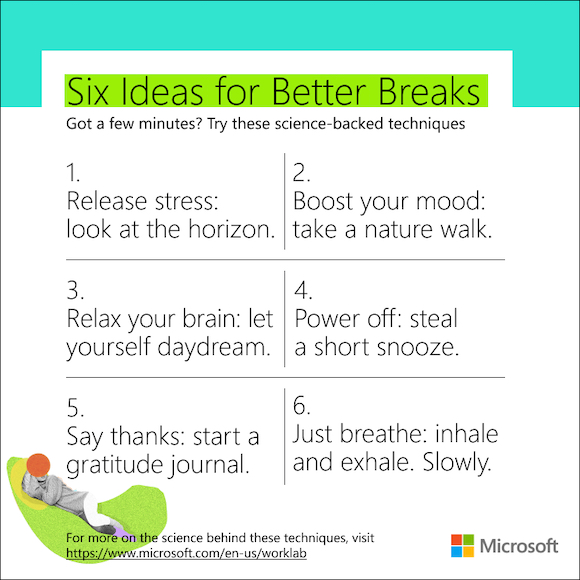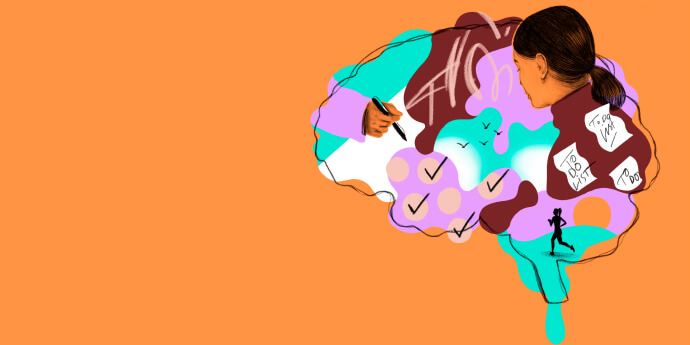In hybrid work , virtual meetings have replaced a lot of our office encounters, from staff summits in the conference room to the casual “Hey, stop by my office.” Meetings will always be an essential part of flexible work, providing a chance for everyone to connect, whether they’re in the office or at home. But overly packed calendars can take a toll on both performance and wellbeing. Is it any wonder that too many back-to-backs can stress us out and cause a collective yawn?
Nope. Research out of Microsoft’s Human Factors Lab indicates that this meeting fatigue impacts our focus and our brains, which desperately crave mini-intermissions between the constant video interactions. Those intervals don’t just reduce stress: they help our brains “reset” and boost our attention for the next task. As little as five minutes can help—and thankfully, there’s plenty of science to back up which activities serve us best in rebooting.
Here are six proven ways to heighten the effect of your next brief hiatus from the screen.
Shift your gaze
The science says: Stanford University neurobiology and ophthalmology professor Andrew Huberman refers to humans as “visual animals” and has tested how our vision prompts what we think and how we feel. His findings show that looking straight ahead and taking in a broader view—as opposed to focusing in on something like a screen—eases our “fight or flight” response.
One method to try: Reducing stress can be as simple as changing your perspective—literally. Little known fact: your eyes are actually part of your brain and central nervous system, and staring at an aggressive email or even expectant faces on a screen can increase your heart rate and ratchet up anxiety. Instead, step away from your screen and look out at a point on the horizon, no matter the environment (though an outdoor setting is ideal), and let your focus soften. Broadening your gaze will soothe the mind.
There’s been a collective realization of how much wellness at work matters for employee performance and satisfaction.
Go green
The science says: According to a study published in the journal Ecopsychology , a nature walk not only boosts your mood but can also lower anxiety and depression. Even viewing images of natural landscapes increases wellbeing, while seeing urban environments dampens an upbeat attitude. “As biological beings, our brains and bodies evolved over millions of years in close concert with our physical world,” says Michael Bohan , senior director of Human Factors Engineering at Microsoft. “Reconnecting with that world can be a great mental and emotional reset.”
One method to try: Propose a walking meeting at a nearby park—or even near some trees. Taking a call? Duck outside and make it an al fresco chat. A 2020 pilot study of information workers found that moderate occupational physical activity (or a leisurely stroll) increased productivity and can improve your mood.
Daydream away
The science says: Research from the University of British Columbia suggests that daydreaming is a crucial cognitive state that helps people sort through problems. Another study published in Proceedings of the National Academy of Sciences shows that “freely moving thought” increases alpha waves in our brains, indicating “wakeful rest.”
One method to try: Psychiatrist Srini Pillay , author of Tinker Dabble Doodle Try: Unlock the Power of the Unfocused Mind , says that “positive constructive daydreaming” is most easily achieved when you plan a dedicated time to let your mind wander—and shut off your senses. Simply close your eyes to start. Then mentally turn inward and encourage your thoughts to meander like a long, lazy river.
6 Strategies for Your Next break

Need a reset? Download this checklist of science-backed techniques to try.
Give some thanks
The science says: In a study conducted by researchers at the University of Miami and the University of California, Davis, participants who jotted down their sources of gratitude (as opposed to a group that listed their aggravations) were more optimistic and content with their lives. That adds up. Another benefit: Research published in the journal Psychological Science notes that being grateful keeps us honest, too.
One method to try: Create a dedicated gratitude journal—whether it’s a notebook or a running digital document—in which you record a few sentences about things you’re grateful for on a daily basis. Your list can run the gamut, from a heady espresso in the morning to your emotional connection to a partner or pal. Chris Schembra, the author of Gratitude and Pasta: The Secret Sauce for Human Connection who runs gratitude workshops for executives, prompts participants to think about the one person they don’t thank enough.
Inhale, exhale
The science says: According to a University of California, Davis study (with a seven-year follow-up), engaging in a daily meditation practice can improve attention span, general psychological wellbeing, and the ability to handle stress. Research from meditation app Headspace points to a performance-based payoff from meditation: better concentration. “After just sitting for 10 minutes, people showed better focus, so their mind was wandering from the task less often,” says Clare Purvis , a clinical psychologist and Headspace’s senior director of behavioral science.
One method to try: Check out Headspace, whose guided meditations and focus music are available in Microsoft Viva Insights in Teams. Another approach is this simple mindfulness exercise from Johns Hopkins Medicine: Take a deep breath in, then exhale. Put one hand on your chest and the other on your abdomen as you repeat the cycle; keep your chest still and let your abdomen expand and contract. Count to keep the pace slow and steady.
Steal a nap
The science says: Before you dismiss an afternoon nap as counterintuitive to productivity—or a pastime with an “image problem”—know that Leonardo da Vinci supposedly took brief “power pisolinos ” every four hours. Even more provocative, a study in the journal Behavioural Brain Research shows that a short daytime snooze bests caffeine as a way to boost performance in verbal memory, perceptual learning, and procedural motor skills like typing or texting. Daytime naps are also associated with reduced blood pressure.
One method to try: If you’re working from home, a bedroom makes the optimal setting because a mattress is easiest on your spine and you can diminish external light and noise. Napping in a chair? Try resting your head on a pillow on your desk or reclining. Just be sure to set an alarm for no more than 30 minutes: “If you sleep longer, you might transition into deep stages of sleep, and you want to save those for the nighttime,” says Dr. Deirdre Conroy, clinical director of the Behavioral Sleep Medicine Program at University of Michigan Health. Nap in the first half of your day, she adds, as snoozing “too close to bedtime can decrease the quality of sleep that you get at night.”
Clearly, our lives and the ways we work have been redefined over the past two years. There’s been a collective realization of how much wellness at work matters for employee performance and satisfaction. Another shift worth celebrating: we’ve gained new autonomy to design our workdays—and even take the occasional energizing nap.

